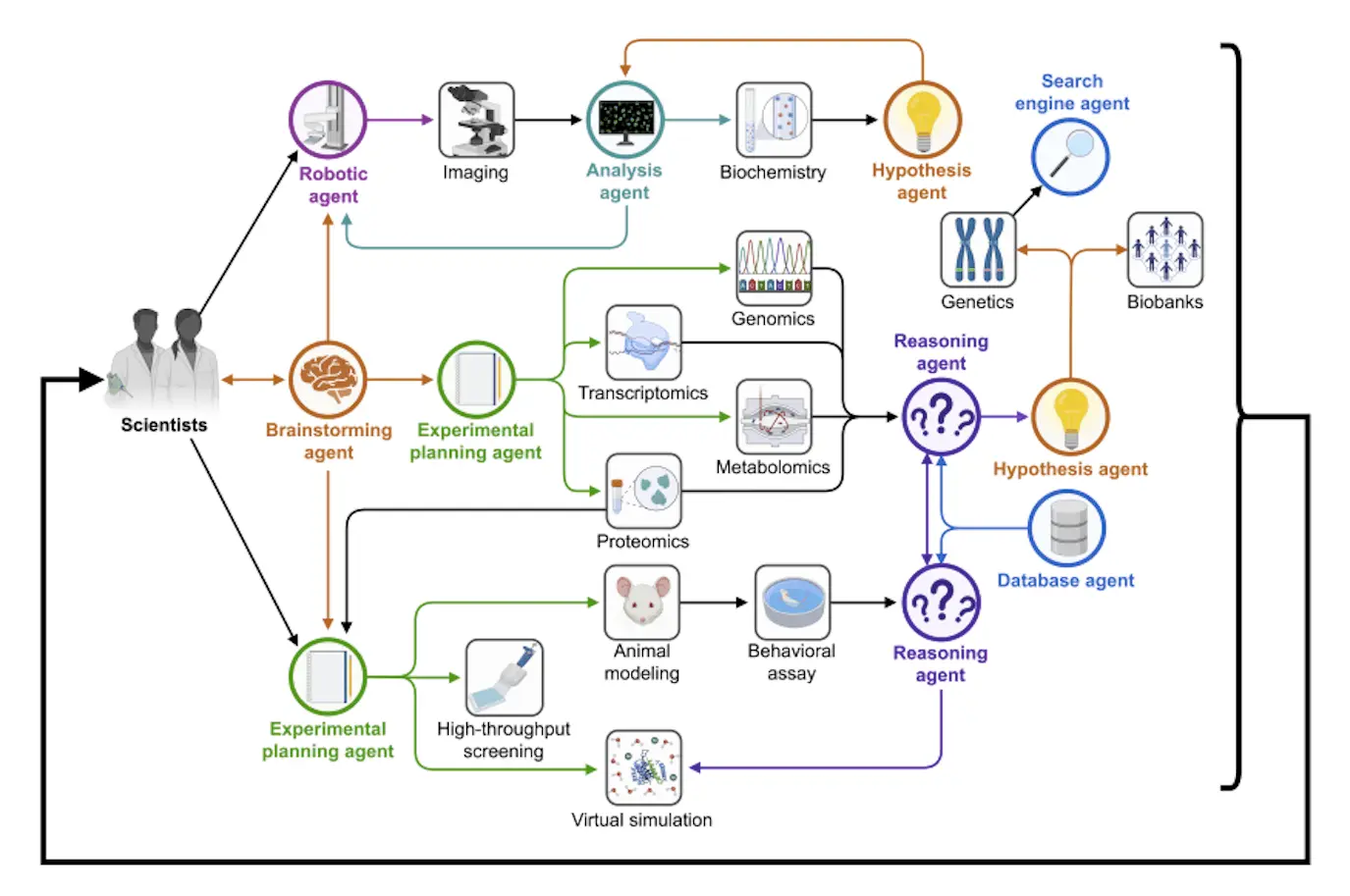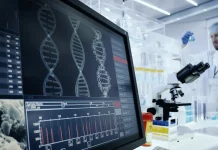Imagine a world where scientific breakthroughs are not just solitary genius work but a collaboration between humans and a new breed of partners- AI lab assistants. It is not science fiction but rather an insight into the future of biomedical research shaped by “AI scientists.”
Recently published article -” Empowering Biomedical Discovery with AI Agents,” by a team from Harvard Medical School and the Broad Institute, a paper champions a revolution in biomedical discovery. These researchers see AI as more than just mere algorithms. They can be seen as systems that can “learn and reason skeptically,” i.e., intelligent companions for labs.
Why AI? The Power of Partnership
But why incorporate AI into the scientific method? This is because biomedical research itself is intricate. It has large data sets, complex hypotheses exploration, and an insatiable thirst for knowledge. While human intuition and creativity are irreplaceable, AI offers distinct strengths:
- Data Analysis Powerhouse: An ability to search through mounds upon mounds of data, allowing them to unearth hidden patterns or relationships that could go unnoticed by humans.
- Hypothesis Exploration On Steroids: This is the situation where AI can examine hypothesis spaces extensively and methodically by going around possibilities that a researcher may miss due to time constraints or cognitive biases.
- The Slayer of Repetitive Task: Science, let’s face it, has repetitious jobs in it. It is these monotonous activities that AI can take care of to allow researchers to concentrate on the larger picture.
Beyond Automation: Merging Creativity with Machine Power
The beauty of AI scientists lies not in their replacement for humans but rather in the amplification of human capabilities. To put it differently, think about gaining a partner who loves nothing but data, does not forget things so easily, and never gets tired. This, however, does not imply that humans are not needed anymore; they are still needed for creative problem-solving abilities, generating new ideas concerning experiments, and critically interpreting the obtained results.
So, what exactly can these AI lab partners do?
The range might be infinite according to human imagination:
- Self-directed Learning Machines: Envisage an AI that is able to analyze data as well as learn from previous research papers and scientific theories. Consequently, it helps the machine stay updated about the world and provides more informed suggestions.
- Incorporating Scientific Toolkit: The ideal AI scientist will, therefore, be something beyond just being good at handling data and knowledgeable of science language. Integration of biological principles and established theories provides a platform where AI can partner with scientific reasoning.
- From Theory to Bench: Bridging the Gap. Turning theory into tangible results is what most scientists consider as the ‘holy grail’ in biomedical research. In this respect, AI may be involved in designing experiments, simulating cellular interactions, and even assisting in the development of new therapies.
However, there’s more!
So far, the blog has been about the core features of an AI scientist. However, to foster better innovation through this partnership, we need to get interactive!
Just think about it:
Imagine yourself as a researcher struggling with the unknown functionality of a novel protein. The sequence, along with other related data sets, is uploaded to your AI colleague’s computer. The computer then searches for patterns and possibly other molecules that could interact with them among these data sets before suggesting some experimental validation methods that include simulation of how the protein might behave under different cell environments.
Let’s Begin Talking!
This is where things start getting interesting. Instead of just plain cold data, AI shows its findings by visualizations like interactive models and hypotheses based on its analysis. You can dig deeper, question its reasoning, propose alternative explanations, or even improve your research plan from this collaborative exchange. This vision is distinguished by the interactive dialogue between humans and AI. It is not simply taking AI pronouncements at face value but a dynamic conversation in a way that uses the strengths of both parties.
The Road Ahead: Challenges and Opportunities
There is no doubt about the potential for biomedical researchers to do so with AI, but several key challenges need to be considered to move forward:
- Ethical Considerations: An AI algorithm is only as good as the data it relies on. Biases in data can result in biased results from AI models. We should, therefore, have robust frameworks that ensure fairness, transparency, and ethical development of research AIs.
- Data Privacy: Most biomedical researchers are working with sensitive patient data. This means strict protocols for maintaining data security and clear patient consent procedures will be essential.
- The Explainability Gap: The “black box” nature of AI makes it hard to fathom the reasoning process that leads to final decisions. Thus, explanatory artificial intelligence models can help researchers comprehend how they make suggestions, thereby promoting scientific trust and strong hypothesis generation.
- The Human Factor: Powerful as they are, scientists based on AI cannot fully replace human expertise. Encouraging a collaborative culture where human beings work side by side with AI.
Alongside these challenges lie exciting opportunities:
- Citizen Science 2.0: Picture AI-powered citizen science platforms where members of the public can contribute to research by analyzing data or identifying patterns (Thomas et al., 2019). This would make scientific discovery more democratic and tap into the collective intelligence of a global community.
- Personalized Medicine Revolution: A patient’s unique genetic and phenotypic data can be analyzed by AI to predict disease risk and personalize treatment plans (Obermeyer & Emanuel, 2016). Preventive medicine may become possible in the future with more focused therapies.
- Accelerating Drug Discovery: The process of discovering new drugs is typically slow and expensive. By analyzing large chemical libraries, AI may determine potential drug candidates, thus significantly speeding up this critical process.
The Future is Collaborative
Biomedical research has begun blending AI scientists into its program in a move not meant to outdo humans but instead to herald a more collaborative tomorrow. When we leverage the respective strengths of human and machine intelligence, we enter an era of scientific discovery that can transform healthcare and improve lives across the globe.
Therefore, do not think of robots in white coats the next time you hear about AI in research. Think about a future where no line separates AI from human researchers, a world where genius does not lead to extraordinary breakthroughs. Rather, they are achieved through a partnership between man and his machine.
The road ahead is full of possibilities. Let’s walk it together!
Article source: Reference Paper
Important Note: arXiv releases preprints that have not yet undergone peer review. As a result, it is important to note that these papers should not be considered conclusive evidence, nor should they be used to direct clinical practice or influence health-related behavior. It is also important to understand that the information presented in these papers is not yet considered established or confirmed.
Follow Us!
Learn More:
Anchal is a consulting scientific writing intern at CBIRT with a passion for bioinformatics and its miracles. She is pursuing an MTech in Bioinformatics from Delhi Technological University, Delhi. Through engaging prose, she invites readers to explore the captivating world of bioinformatics, showcasing its groundbreaking contributions to understanding the mysteries of life. Besides science, she enjoys reading and painting.
















